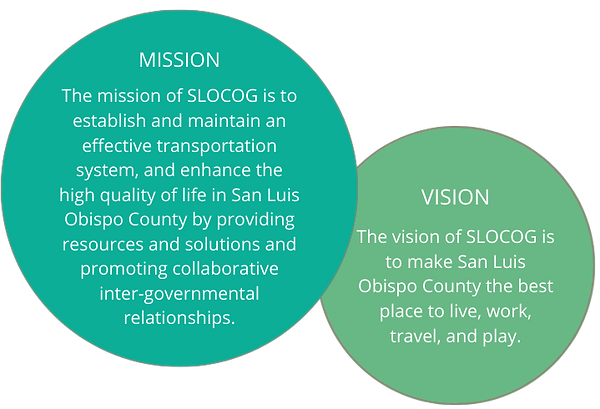
About SLOCOG
Current Updates
SLOCOG Celebrates Over 25 Years of Clean Audits
SLOCOG is pleased to announce another clean bill of financial health! The 2024 San Luis Obispo Council of Governments Fiscal Audit and 2024 TDA Compliance Single Audit, as prepared by Brown Armstrong CPAs, were submitted to the Board at the December 4, 2024 meeting. There were no financial statement or federal award audit findings or questioned costs for fiscal year 2023-24, which ended June 30, 2024. This puts SLOCOG in compliance with Government Auditing Standards.
WHAT IS SLOCOG?
The San Luis Obispo Council of Governments (SLOCOG) connects the communities in our region by directing transportation and land use planning efforts and allocating federal and state transportation funds, while providing a forum for local elected officials, transportation experts, and members of the community to work together to improve mobility for residents, businesses, and visitors.
OUR REGION
The boundaries of the San Luis Obispo Region correspond with the jurisdictional lines of San Luis Obispo County. Located on the Central Coast about halfway between San Francisco and Los Angeles, the region boasts 3,326 square miles of land area, 96 miles of coastline, and over 280,000 residents.

SLOCOG is an association of local governments, including San Luis Obispo County and its seven cities: Arroyo Grande, Atascadero, Grover Beach, Morro Bay, Paso Robles, Pismo Beach, and San Luis Obispo. Together, these jurisdictions make up the San Luis Obispo Region.
The region has a strong rural character mixed with attractive urban areas, most of which are located along the U.S. Highway 101 corridor. Communities in the region are unique in terms of their setting, population, economy, and environment. They provide a wide variety of urban amenities, employment and educational opportunities, natural landscapes, agricultural products, and recreational and tourist-oriented activities.
The region’s urban areas are linked by the primary north-south transportation corridors of U.S. 101, S.R. 1, and S.R. 227. U.S. 101 stretches over 70 miles in the region, offering connections to the San Francisco Bay Area and the Greater Los Angeles Area. Due to its location, natural amenities, and temperate weather, the region is a popular tourist destination, resulting in additional traffic congestion during peak tourist periods. An estimated 7 million Californians are within a three-hour drive of the San Luis Obispo Region.
WHAT IS REGIONALISM?
By the late 1960s, most urbanized areas with populations of 50,000+ began planning for their communities in a comprehensive, multijurisdictional way, giving rise to the idea of regional planning. Regional Councils, or COGs, are public agencies dedicated to serving local governments by seeking solutions to problems that go beyond a single jurisdiction and cannot be addressed at the local level.
Cities and towns are not walled places—to succeed they need to be able to compete in the regional, state, national, and global marketplace. Regional councils provide a forum where jurisdictions can work together to respond to regionwide challenges. MPOs are charged by the federal government to carry out the regional planning process for transportation.
What Does SLOCOG Do?
SLOCOG provides leadership in transportation planning by engaging the public and fostering effective partnerships throughout the San Luis Obispo (SLO) Region. We help ensure the transportation system safely and efficiently moves people and goods through various transportation modes. We partner with other government agencies and local organizations to support a thriving region that is inviting to visitors and attractive to diverse business interests.
Whether you are cruising along U.S. Highway 101, navigating an RTA bus transfer at the SLO Transit Center, bicycling along the Bob Jones Trail, walking your children to school, commuting to work, or delivering produce to market, SLOCOG is working to help you move about the region.
To do this, SLOCOG delivers long-range planning documents that help our region and its jurisdictions chart a path forward for transportation, housing, and land use concerns, anticipating the needs we will have as the region grows. In addition to preparing the region’s long-range planning documents, SLOCOG plans and provides funding for public transit services, highway and roadway improvements, and alternative modes of transportation, such as walking, biking, and vanpooling.
SLOCOG Timeline
1968
Region forms San Luis Obispo County and Cities Area Planning and Coordinating Council (SLOCCAPCC - whew!) through a Joint Powers Agreement (JPA) among the incorporated cities and the County of San Luis Obispo, designated as the Regional Planning Agency and the Regional Transportation Planning Agency
1972
Begins allocating State transportation funds
1973
Board adopts first Regional Transportation Plan (RTP) and begins allocating newly enacted Federal transportation funds
1980
SLOCACOG funds the creation of SLO Regional Rideshare at the County offices
1985
SLOCACOG adopts a new name and is now known as the San Luis Obispo Council of Governments (SLOCOG)
1989
SLOCOG helps form a single, consolidated Regional Transit Authority (RTA), providing transit services countywide
1991
SLOCOG also becomes the Metropolitan Planning Organization (MPO) and begins programming Federal dollars
1993
SLOCOG becomes an independent agency, officially separating from the County of San Luis Obispo. Also becomes a Census Data Affiliate (CDA) Center
1994
SLOCOG facilitates the formation of the county wide "Integrated Waste Management Authority" to provide a region wide plan and program to reduce solid and hazardous wastes
1996
SLOCOG is designated a Service Authority for Freeways and Expressways (SAFE)
1997
US 101 South County Major Investment Study is developed
2007
SLOCOG brings SLO Regional Rideshare program in-house
2008
SLOCOG integrates land use and transportation planning with the Community 2050 Regional Blueprint
2013
SLOCOG rebrands with a fresh look and new outreach strategies.
2018
SLOCOG celebrates 50 Years of Connecting Communities
